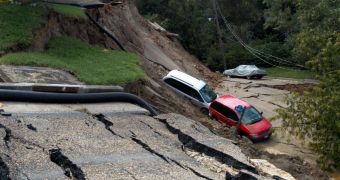In a giant outdoor laboratory, scientists used artificial landslides to uncover crucial details on these natural disasters, in an attempt to improve forecasts of their size and impact.
In order to do so, they built a 2-meter-wide, 95-meter-long (6-foot-wide, 310-foot-long) slide – also called a 'flume', and have sent tons of gravel, sand, mud and water crashing down its roughly 30-degree slope over the years.
These real-size experiments allowed them to place electronic pressure and erosion sensors inside the slide, so they were able to measure how these artificial landslides grew or slowed down.
But there was a lot of physical work necessary, for preparing each and every experiment.
Richard Iverson, a research hydrologist at the US Geological Survey's Cascades Volcano Observatory in Vancouver, Washington, explained that “running a single experiment takes about 10 to 15 person-days of effort to get it set up and run, involving loading the sediment, wetting it and letting it go.
“Others who have thought of building something similar have come to visit us and then decided not to do it because they thought it quite daunting.
“It's the only facility of this kind in the world.”
Most landslides are triggered when intense rainfall or snowmelt loosens steep, debris-laden slopes, and the torrents can then grow dramatically in size and speed by sweeping up extra material from their beds and banks.
But until now, it was no sure in which way they grew, and many scientists were confused since the energy needed to drag in extra matter should actually slow these flows down.
Miniature landslides have been studied on a benchtop scale before but the best way to understand a real landslide is to study one of a similar size.
This was the reasoning behind the building of the outdoor lab containing full-scale landslides, and in the end, all the researchers' hard work paid off.
They found out that the reason for which landslides gained mass and speed was the presence of a bed of wet sediment (debris flowing over dry dirt slowed down and grew less in size).
Iverson said that “the thing that was unanticipated, and also the most important, was how much the momentum of flows could grow.
“In the course of less than 100 meters (330 feet) of interacting with beds of wet sediment, these flows quadrupled in momentum when on beds of wet sediment compared to flows that moved across bare beds.”
The researchers suggested that the reason for which landslides grew over wet ground was because the weight of the flow rises the water pressure between sediment grains, and this lubricates the base of the torrent, causing it to gain mass and speed.
“These findings help us refine our mathematical models for forecasting hazards,” said Iverson.
“We can't prevent natural events from happening in most cases, but we can try to issue increasingly accurate warnings based on information from experiments like this.”
The findings are detailed online in the journal Nature Geoscience, OurAmazingPlanet reports.

 14 DAY TRIAL //
14 DAY TRIAL //